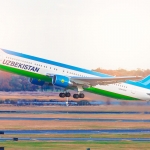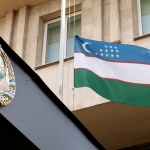05 SEPTEMBER 2019 Y.
When we reached Rukhabad, we heard an amazing prayer – azan. Azanchi was calling all believers for praying, its sound filled the whole Gur- Emir Square. We followed the sound and entered ancient and mysterious Rukhabad and froze.
Rukhabad is favourite site of pilgrims and is a grave of Saint Burkhaneddin Sagaradji, a preacher and wonder-worker. They say that in the past when believers were coming to worship the Stain they were leaving their autographs on the walls. After restoration the inscriptions were removed but there were so many of them that love of people to Burkhaneddin was doubtless. They say also that a casket with seven hair of the Prophet which he had brought from Mekkah are walled up there.
But who was Burkhaneddin? He was a preacher from Mekkah who was sent to Samarkand to enlighten local people about Islam. The power of his oratorical skill and persuasion was so strong that soon he had nothing to do in Samarkand as all town inhabitants have already been perfect Muslims. Burkhaneddin went to preach to China.
There is a legend about two miracle-workers, Chinese one and Arab one, who had to amaze Chinese Emperor. People are the same everywhere, they cannot just believe, they need miracles. Chinese miracle-worker decided to strike the Emperor and the audience with the ability to fly. He flew into the air and soared. Burkhaneddin, in his turn, prayed, took off his shoe and threw it into Chinese miracle-worker who fell.
Of course, it is just a legend. The truth is that it was not easy for preachers in foreign countries. But thanks to Burkhaneddin’s efforts, there were many Muslims in China at that time. Samarkand and Samarkand entrepreneurs were respected there, had influence on politics and economy.

Burkhaneddin returned to Samarkand not alone. He came back with a wife, Chinese princess who adopted Islam, of course. They had nine children. Before his death Burkhaneddin willed to bury him in Samarkand. All of them were buried in one place of Rukhabad which according to Muslim traditions of that time was a “familiarity”. In the mausoleum both men and woman were buried together which was allowed only in cemetery. Mausoleums were always separate and men and women were not buried together.
The time of construction is about 9th century. During Temur times the mausoleum was a little bid reconstructed and restored, a block mosque was built here which later became Friday mosque. The sound of beautiful azan was coming from there… The building survived Genghis Khan invasion, as much as it was possible. Of course, the surrounding block – rabat – was destroyed and burned.
They say that Temur never rode the horse when passing Rukhabad, he was always filled with respect to the Saint. He planned to build the madrassa in honor of his grandson Mukhammad-Sultan (today, Gur-Emir) between graves of two Saints – Burkhaneddin and Mir-Said Umar, protector of ceramics and pots masters. Now, the grave of Mir-Said Umar is located in Gur-Emir and great Temurids are buried between the Saints. When you are inside there, pay attention to the grave aside the center – this is the grave of protector of the craftsmen.
Today, there are craftsmen stores in Rukhabad, which is right. Since ancient times this place belonged to craftsmen.
Who knows, may be Omar Khayyam walked these streets and admired the pots which according to him were the dust of the worthless and the great…














